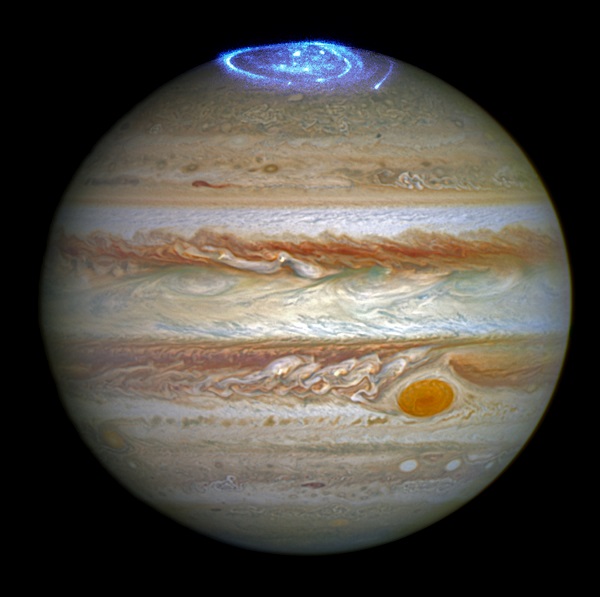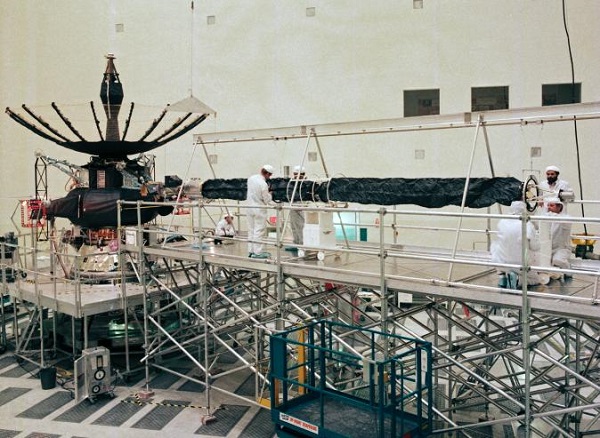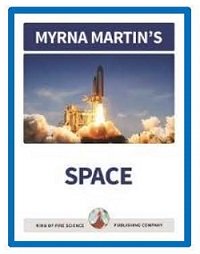Fascinating Facts About Jupiter
Jupiter, gas giant of the solar system
Jupiter is the 4th brightest object in the sky
People looking at the lights in the sky at night could easily see Jupiter because it is the fourth brightest object in the sky.
Jupiter was given many different names by different cultures. The Babylonians called Jupiter Marduk. Marduk was the patron god of the city of Babylon. The Greeks called the planet Zeus and the Egyptians Her-wepes-tawy.
Jupiter is the king of the gods in ancient Roman religion and mythology. He was the god of the sky and thunder. Over time as the Roman influence spread to many cultures Jupiter was adopted as the official name for the planet.
Auroras and storms on the surface of Jupiter

Jupiter is best known for the colorful cloud formations on the surface of the planet. This picture includes far-ultraviolet images of Jupiter's auroras that have formed on its north and south poles by the Hubble Space Telescope. NASA/ESA Hubble Space Telescope
Galileo's observations and discoveries
Galileo's observations and the heliocentric theory
Galileo's discoveries led to the birth of modern astronomy when he observed that the "stars" around Jupiter were really moons that orbited the planet. His discoveries led to the acceptance of the heliocentric theory put forth by Copernicus in the 1500s. The heliocentric theory states that the Sun is at the center of the universe instead of the Earth.
Geocentric theory
The geocentric theory prevailed before this time. The geocentric theory stated that the Sun Moon, stars and planets all orbited the Earth. Many ancient civilizations also thought the Earth was the center of the universe and all objects in the sky orbited around the Earth.
Galileo's 1609-1610 discoveries
Galilean moons
Galileo Galilei in 1609-1610 looking through his telescope at Jupiter discovered its four largest moons. He named the moons Io, Europe, Ganymede and Callisto. Today, they are called the Galilean moons in his honor. Galileo's telescope was not powerful enough to observe the other 75 known moons that orbit Jupiter.
Ganymede
Ganymede is the largest moon in the Solar System. It has its own magnetic field. The moon also has auroras that are ribbons of light caused by the glowing gases around its north and south poles. Ganymede is composed of equal part silicate rock and water ice.
Ganymede has an iron-rich liquid core and an internal ocean. NASA scientists believe the ocean beneath the icy crust could contain more water than all oceans on Earth combined.
Callisto
Callisto was discovered by Galileo in 1610. It is the third largest moon in the Solar System. Saturn's Titan moon and Ganymede are larger. Callisto orbits Jupiter once every 17 days and is only 1% smaller than Mars. The moon has more craters on its surface than any other object in the Solar System.
Io
Io is smaller than Ganymede and Callisto but is denser than Jupiter's other moons. Hundreds of volcanoes are still active on Io. Some of the volcanoes are erupting fountains of lava high above the moon's surface. Ganymede and Callisto cause tidal forces on the planet. The tidal forces cause the planet to bulge up and down as much as 100 meters.
Europa
Europa is the sixth largest moon in our Solar System. It is slightly smaller than our Moon. and its surface is covered with icy water. Beneath the icy water crust is probably a salty ocean. Europa is a dense moon. It has a similar composition to the terrestrial planets in our Solar System.
Europa is the smoothest known object in the Solar System. There are no mountains and few craters on Europe. Its most striking surface feature is a series of dark streaks crisscrossing the entire surface of the moon. Scientists aren't sure what caused the dark streaks to form on the surface of the moon.

Our Space textbook contains sixteen chapters and 136 pages of information about our universe. It includes chapters on Jupiter, Solar System, stars and galaxies. We also offer an e-book with the same information that saves you money and can be downloaded immediately. Myrna Martin
Click for More Information and to Order
Jupiter and the Solar System
Planets visible from Earth
Mercury, Venus, Mars, Saturn and Jupiter are the only
planets visible from Earth with the unaided eye. Jupiter is the largest planet
in the Solar System. It is larger than all the other planets combined. It is 11
times bigger than Earth and 1,321 Earth’s could fit inside the planet.
Astronomical units
Earth is 1 astronomical unit (AU) from the Sun. Jupiter’s average
distance from the Sun is 5.2 AU. Its orbit is an oval with its distance varying
from 4.9 AU to 5.4 AU
Jupiter’s day and year
Jupiter is the fifth planet from the Sun. The orbit of
Jupiter is four times further away from the Sun than Earth. It takes 43 minutes
for sunlight to reach the planet.Jupiter rotates on its axis approximately once every 10
hours. It has the shortest day of all the planets in the Solar System. A Jupiter
year is 12 Earth years long.
Jupiter's atmosphere
A gas giant planet
Jupiter is a gas
giant without a solid surface where a spacecraft could land. The atmosphere on
Jupiter is 5,000 km thick. The air pressure increases as it nears the core of
the planet.
The designated base of the atmosphere ends when the atmospheric pressure is 100kPa (1bar). The base of Jupiter atmosphere is the same pressure as the pressure on Earth at sea level.
Zones and belts of clouds
You will see bands of light and dark clouds that constantly flow around
the surface of Jupiter if you look through a telescope. Each of these bands of
color are bordered by jet streams.
Areas of high and low air pressure cause the clouds on Jupiter to flow constantly east or west. When the clouds flow clockwise, they form cyclones and anticyclones when they flow counterclockwise.
Zones are high pressure areas
Zones are the light areas in Jupiter’s atmosphere when you look
through a telescope or see pictures of the planet. The zones are bands of
clouds that form in high pressure areas circulating counterclockwise. The areas
of high-pressure zones form high-altitude clouds of white ammonia ice. The
ammonia ice clouds obscure the deeper and more colorful layers of clouds below.
Belts are low pressure areas
Belts are the darker areas you see on the surface of
Jupiter. The air inside the belts circulate clockwise in low pressure areas.
The ammonia ice clouds are not thick enough to obscure the deeper layers of clouds
that contain ammonium sulfide, ammonium hydrosulfide, and organic compounds.
These chemical and organic compounds give the belts their brownish color.
Jupiter's powerful lightning storms
Powerful lightning storms have been observed on the surface
of Jupiter. The lightning strikes on Jupiter are much more powerful that
lightning strikes on Earth. The lightning is caused by convection that starts
deep within the planet. Gases, including water vapor, form ice particles as
they are rising. The ice particles in the rising gases rub past each other building
a charge until they are discharged as lightning.
Jupiter's Great Red Spot
Observed continuously since 1831
The Great Red Spot is a massive storm that has been observed
continuously since 1831. The storm is larger than Earth and has raged for
hundreds of years.
Earlier observations of the planet indicate that the storm might have been observed by astronomers between 1665 and 1713. No one knows if the astronomers saw the Great Red Spot or a different storm that might have dissipated after 1713,
Great Red Spot may be shrinking in size
The Great Red Spots rotates counterclockwise once every 6
days. It seems to be shrinking in size during the last 100 years. In 1904 the
length of the storm was approximately 40,000 km long.
In 2004 the length of the storm was about half the size it was in 1904. The storm’s edges in 2019 began breaking off and dissipating. At the present rate it is decreasing in size the Great Red Spot may become round instead of an oval by 2040.
Jupiter's core
Theories about Jupiter’s core
It was suspected that Jupiter had a dense core surrounded by
a layer of liquid metallic hydrogen with some helium mixed in that extends
outward from the center of Jupiter.
Jupiter’s diffuse core
The Juno probe found that the planet has solid rocks mixed with
a bubble of hydrogen gas that creates a diffuse core instead of a dense solid
core. Scientists theorize that a planet may have smashed into Jupiter causing
the diffuse core in the early days of the formation of the solar system.
Temperature of the diffuse core
The gas in the diffuse core becomes hotter and denser as it
nears the center of the planet. The exact temperature of Jupiter’s core is
unknown. Scientists estimate the temperature is about 24,000 degrees Celsius
(43,000 degrees Fahrenheit). If true, Jupiter’s core is hotter than the surface
of the Sun.
Magnetic Fields at the North and south pole
Electrical current between Io and Jupiter
Jupiter has a strong magnetic field at each of its poles.
Every 10 hours the magnetic field rotates in a circle. Io is one of Jupiter’s
moons that was discovered by Galileo. Every 1.8 days Io orbits around Jupiter.
Magnetosphere
The magnetic field (magnetosphere) sweeps past the planet at
a high velocity creating a huge electrical current between Io and Jupiter. The
output of this electrical current is about 2 trillion watts. It is about the
same amount of power that is produced by all the power plants on Earth.
Auroras on Jupiter
Hubble Space Telescope far-ultraviolet images
Scientists have been studying the Auroras on Jupiter using
the Hubble Space Telescope. The telescope produced far-ultraviolet images for
several months as the NASA’s Juno spacecraft approached the planet studying the
solar wind.
Glowing red, green and purple auroras
The auroras are huge, and they never cease. The auroras are
powered by charged particles in the upper atmosphere, the solar wind, and
charged particles produced by the moon Io. These high-energy particles enter
the planet’s atmosphere and collide with gas particles near its magnetic poles
to glow red, green and purple. They are twenty times more energetic than auroras
on Earth.
Galileo Spacecraft being built

The Galileo spacecraft as it was being built on November 1, 1984 at the JPL's Spacecraft Assembly Facility. The workers are wearing protective gear in the clean room so the spacecraft would not be contaminated before being launched into space. NASA/JPL-Caltech
Robotic Spacecraft to Jupiter
Galileo's mission
The Galileo spacecraft was an unmanned space probe. It was
launched on October 18, 1989 to study Jupiter with 10 science instruments and a
descent probe that took samples of Jupiter’s atmosphere. The spacecraft did not
have enough fuel to fly to Jupiter so Galileo orbited Venus and Earth in flybys
to get enough momentum to reach Jupiter. The Galileo mission lasted fourteen
years.
On the trip to Jupiter the spacecraft flew past two asteroids, had direct observations of a comet Shoemaker-Levy crashing into a planet, and a flyby of Venus.
Other discoveries made by the Galileo spacecraft included the existence of an ocean beneath Europa’s icy surface, volcanic activity on Io and a magnetic field on Ganymede.
Galileo was the first spacecraft to orbit Jupiter. The spacecraft mission ended on September 21, 2003 when Galileo plunged into Jupiter’s atmosphere to keep it from colliding with Europa and harming its ocean.
NASA’s Juno spacecraft and mission
People have wondered about the structure of the planets
since Galileo discovered the bright lights in the skies were not stars but planets
that orbited the Earth.
The Juno spacecraft was launched on August 5, 2011. It arrived on July 4, 2016 to study the atmosphere of the planet. It is in polar orbit around the planet. The space probe was powered by solar panels to travel to Jupiter and power the various instruments on the spacecraft while circling the planet.
Information being gathered by Juno
The spacecraft is sending back information on the planet’s
composition including its core. Information from the various instruments on the
spacecraft will study its gravity field, magnetic field and polar
magnetosphere.
Scientists are also studying the amount of water in its atmosphere, how its mass is distributed and the winds in the clouds.
The Juno spacecraft is still operational as it continues to send back information to NASA. When the mission is ended it will plunge into the atmosphere of Jupiter where it will burn up.
Comet Shoemaker-Levy 1994
Gravity captures the comet
The gravity of Jupiter captured the comet Shoemaker-Levy
causing it to orbit the planet. The orbiting comet was broken apart by
Jupiter’s gravity. The comet and its fragments continued to orbit the planet
for two years before being destroyed.
The comet collides with Jupiter
NASA’s Galileo orbiter was enroute to the planet in 1994. The
orbiter took photographic images of the collision when the comet crashed into
Jupiter in July 1994. Between July 16 and July 22 twenty fragments of the comet
collided with Jupiter. It was the first-time astronomers were able to observe the
actual collision of two extraterrestrial bodies colliding in our Solar System. The
information gathered about the collision provided new information about the
composition of Jupiter’s atmosphere.
Fireballs Striking Jupiter
Voyager 1 photographed a fireball in March 1979 striking Jupiter.
July 19, 2009 an impact crater was discovered that warmed the lower atmosphere near Jupiter’s south pole.
June 3, 2010 Anthony Wesley, an amateur astronomer in Australia, detected an impact on Jupiter. An amateur astronomer in the Philippines captured the impact on video.
August 20, 2010 Christopher Go, in Cebu, Philippines detected a fireball striking Jupiter.
March 17, 2016 an asteroid or a comet struck Jupiter. A video of the impact was filmed by Gerrit Kernbauer, an Austrian amateur astronomer. He was studying the planet with his 20-centimeter telescope when he observed the event.
KIDS FUN Science Bookstore
Check out Myrna Martin's award winning textbooks, e-books, videos and rock sets. The Kids Fun Science Bookstore covers a wide range of earth science topics. Click here to browse.











